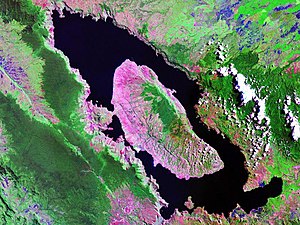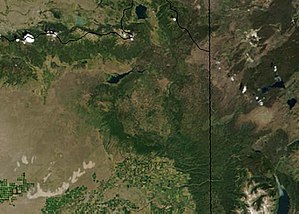This is an old revision of this page, as edited by SmackBot (talk | contribs) at 18:36, 20 October 2007 (Date/fix the maintenance tags or gen fixes). The present address (URL) is a permanent link to this revision, which may differ significantly from the current revision.
Revision as of 18:36, 20 October 2007 by SmackBot (talk | contribs) (Date/fix the maintenance tags or gen fixes)(diff) ← Previous revision | Latest revision (diff) | Newer revision → (diff) For other uses, see Caldera (disambiguation).
A caldera is a volcanic feature formed by the collapse of land following a volcanic eruption. They are often confused with volcanic craters. The word 'caldera' comes from the Spanish language, meaning "cauldron".
Caldera formation
A collapse is triggered by the emptying of the magma chamber beneath the volcano, usually as the result of a large volcanic eruption. If enough magma is erupted, the emptied chamber will not be able to support the weight of the volcanic edifice (the mountain) above. Fractures will form around the edge of the chamber, usually in a roughly circular shape. These ring fractures may in fact serve as volcanic vents. As the magma chamber empties, the center of the volcano within the ring fractures begins to collapse. The collapse may occur as the result of a single massive eruption, or it may occur in stages as the result of a series of eruptions. The total area that collapses may be hundreds or thousands of square kilometers.

Explosive calderas
If the magma is rich in silica, the caldera is often filled in with ignimbrite, tuff, rhyolite, and other igneous rocks. Silica-rich magma is slow flowing or has high viscosity. As a result, gases tend to become trapped at high pressure within the magma. When the magma gets near the surface of the Earth, the gas expands quickly, causing explosions and spreading volcanic ash over wide areas. Further lava flows may be erupted, and the center of the caldera is often uplifted in the form of a resurgent dome by subsequent intrusion of magma. A silicic or rhyolitic caldera may erupt hundreds or even thousands of cubic kilometers of material in a single event. Even small caldera-forming eruptions, such as Krakatoa in 1883 or Mount Pinatubo in 1991, may result in significant local destruction and a noticeable drop in temperature around the world. Large calderas may have even greater effects.
When Yellowstone Caldera (last) erupted 640,000 years ago it released 1,000 cubic kilometers of material, covering all of North America in up to two meters of debris. By comparison, when Mount St. Helens erupted in 1980, it released 1.2 cubic kilometers of ejecta. The ecological effects of the eruption of a large caldera can be seen in the record of the Lake Toba eruption in Indonesia. About 75,000 years ago, this volcano released 2,800 cubic kilometers of ejecta, the largest known eruption within the Quaternary Period (last 1.8 million years). In the late 1990s, archeologist Stanley Ambrose proposed that a volcanic winter induced by this eruption reduced the human population to a few thousand individuals, resulting in a population bottleneck (see Toba catastrophe theory). Even larger caldera-forming eruptions are known, especially La Garita Caldera in the San Juan Mountains of Colorado, where the 5,000 cubic kilometer Fish Canyon Tuff was blasted out in a truly major single eruption 27.8 million years ago.
At some points in geologic time, rhyolitic calderas have appeared in distinct clusters. The remnants of such clusters may be found in places such as the San Juan Mountains of Colorado (erupted during the Tertiary Period) or the Saint Francois Mountain Range of Missouri (erupted during the Proterozoic).

Non-explosive calderas
Some volcanoes, such as Kīlauea on the island of Hawaii, form calderas in a different fashion. In the case of Kilauea, the magma feeding the volcano is relatively silica poor. As a result, the magma is much more viscous than the magma of a rhyolitic volcano, and the magma chamber is drained by large lava flows rather than by explosive events. The resulting calderas are also known as subsidence calderas, and can form more gradually than explosive calderas. For instance, the caldera atop Fernandina Island underwent a collapse in 1968, when parts of the caldera floor dropped 350 meters. Kilauea Caldera has an inner crater known as Halema‘uma‘u, which has often been filled by a lava lake. The largest volcano on Earth, Mauna Loa is also capped by a subsidence caldera called Moku‘āweoweo Caldera.
Non-volcanic calderas
It is possible, although rare, for a caldera-like formation to be created by erosion rather than volcanism. The Caldera de Taburiente on La Palma in the Canary Islands may be example of this.
Notable calderas
See also Category:Volcanic calderas
- Africa
- Ngorongoro Crater (Tanzania, Africa)
- Mount Elgon (Uganda/Kenya)
- Chã das Caldeiras, Cape Verde
- See Europe for calderas in the Canary Islands
- Asia
- Aira Caldera (Kagoshima Prefecture, Japan)
- Aso (Kumamoto Prefecture, Japan)
- Mount Halla (Jeju-do, South Korea)
- Kikai Caldera (Kagoshima Prefecture, Japan)
- Krakatoa, Indonesia
- Mount Pinatubo (Luzon, Philippines)
- Taal Volcano (Luzon, Philippines)
- Lake Toba (Sumatra, Indonesia)
- Mount Tambora (Sumbawa, Indonesia)
- Tao-Rusyr Caldera (Onekotan, Russia)
- Towada (Aomori Prefecture, Japan)
- Tazawa (Akita Prefecture, Japan)
- Ashi (Kanagawa Prefecture, Japan)


- Americas
- USA
- Battle Ground Lake State Park (Washington, US)
- Mount Aniakchak (Alaska, US)
- Crater Lake on Mount Mazama (Crater Lake National Park, Oregon, US)
- Mount Katmai (Alaska, US)
- La Garita Caldera (Colorado, US)
- Long Valley (California, US)
- Island Park Caldera (Idaho, US)
- Newberry Caldera (Oregon, US)
- Mount Okmok (Alaska, US)
- Valle Grande (New Mexico, US)
- Yellowstone Caldera (Wyoming, US)
- Canada
- Mount Silverthrone (British Columbia, Canada)
- Mount Edziza (British Columbia, Canada)
- Bennett Lake Volcanic Complex (British Columbia/Yukon, Canada)
- The Ash Pit (British Columbia, Canada)
- Mount Pleasant Caldera (New Brunswick, Canada)
- Sturgeon Lake Caldera (Ontario, Canada)
- Mount Skukum Volcanic Complex (Yukon, Canada)
- Blake River Megacaldera Complex (Quebec, Canada)
- Other
- USA
- Europe

- Oceania
- Antarctica
- Indian Ocean
- Mars
- Olympus Mons Caldera
- Venus
- Maat Mons Caldera
See also
External links
- USGS page on calderas
- List of Caldera Volcanoes
- Collection of references on collapse calderas (43 pages)
- The Caldera of the Tweed Volcano - Australia
- Largest Explosive Eruptions: New results for the 27.8 Ma Fish Canyon Tuff and the La Garita caldera, San Juan volcanic field, Colorado
References
- Peter Lipman (1999). "Caldera". In Haraldur Sigurdsson, ed. Encyclopedia of Volcanoes. Academic Press. ISBN 0-12-643140-X